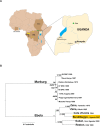Newly discovered ebola virus associated with hemorrhagic fever outbreak in Uganda
- PMID: 19023410
- PMCID: PMC2581435
- DOI: 10.1371/journal.ppat.1000212
Newly discovered ebola virus associated with hemorrhagic fever outbreak in Uganda
Abstract
Over the past 30 years, Zaire and Sudan ebolaviruses have been responsible for large hemorrhagic fever (HF) outbreaks with case fatalities ranging from 53% to 90%, while a third species, Côte d'Ivoire ebolavirus, caused a single non-fatal HF case. In November 2007, HF cases were reported in Bundibugyo District, Western Uganda. Laboratory investigation of the initial 29 suspect-case blood specimens by classic methods (antigen capture, IgM and IgG ELISA) and a recently developed random-primed pyrosequencing approach quickly identified this to be an Ebola HF outbreak associated with a newly discovered ebolavirus species (Bundibugyo ebolavirus) distantly related to the Côte d'Ivoire ebolavirus found in western Africa. Due to the sequence divergence of this new virus relative to all previously recognized ebolaviruses, these findings have important implications for design of future diagnostic assays to monitor Ebola HF disease in humans and animals, and ongoing efforts to develop effective antivirals and vaccines.
Conflict of interest statement
The authors have declared that no competing interests exist.
Figures

References
-
- Suzuki Y, Gojobori T. The origin and evolution of Ebola and Marburg viruses. Mol Bio Evol. 1997;14(8):800–806. - PubMed
-
- Sanchez A, Geisbert TW, Feldmann H. Filoviridae: Marburg and Ebola Viruses. In: Knipe DM, Howley PM, editors. Fields Virology. Philidelphia: Lippincott Williams and Williams; 2007. pp. 1409–1448.
-
- Leroy EM, Kumulungui B, Pourrut X, Rouquet P, Hassanin A, et al. Fruit bats as reservoirs of Ebola virus. Nature. 2005;438:575–6. - PubMed
Publication types
MeSH terms
Substances
LinkOut - more resources
Full Text Sources
Other Literature Sources
Medical
Molecular Biology Databases
Research Materials
Miscellaneous

